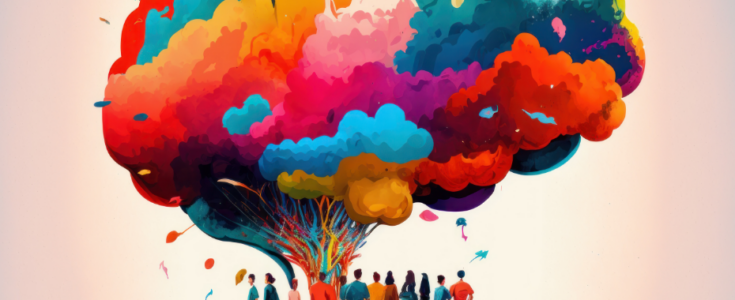
Combining Design Thinking and Usability Testing for Superior UX

User experience (UX) is all about understanding the needs of the user and providing solutions in the digital products we design that directly address the issues they are facing. We lean on the principles of design thinking to gain an understanding of customers, the challenges they face, and the goals they are trying to achieve in a series of collaborative cross-functional team exercises. The aim is to provide solutions that better meet the customer’s needs, thereby creating users who are passionate about the products and services offered. While design thinking offers a creative foundation for designing, usability testing validates our ideas to move forward or confirm when we need to iterate and go back to the drawing board.
Together, design thinking and usability testing enable UX teams to create with the user in mind, enterprises to launch products with confidence, and users to thoroughly enjoy their digital experiences.
Design Thinking and UX Design
Design thinking is the practice of understanding customers, the challenges they face, and the goals they are trying to achieve in a series of collaborative, creative, cross-functional team exercises. The aim is to provide solutions that better meet the customer’s needs, thereby creating users who are passionate about the products and services offered. A collaborative mindset that invites participants to empathize with our end-users and bring about solutions based on their real experiences is an important part of the design thinking process. It’s all about keeping an open mind, not immediately solutioning, and staying curious.
Having an open-minded in design thinking means we challenge assumptions and open to different perspectives by exploring new ideas from various angles. An open mind also allows our designers to be receptive to feedback and incorporate it into our design process.
In relation to UX, design thinking is a matter of relying on both convergent and divergent thinking to get to a place of good design solutions. Relying heavily on divergent thinking helps us understand our users. The objective is to identify who the users are and gain an understanding of their needs, wants, frustrations, and goals. Ultimately, you want to comprehend how they do their tasks and how they really work. With this knowledge, we can then use convergent thinking to focus on a single user and their task and the issues/frustrations they face with our application.
UX-Related Findings
Speaking of understanding our users, design thinking and UX in general takes a great deal of empathy. UX-related findings like personas and journey maps humanize the design process and help us develop empathy for our users.
We create user personas based on characteristics that represent the needs of a larger group of users. These include age, gender, education, experience, needs, motivations, preferences, and behavior. UX personas are designed to identify the needs, goals, desires, and challenges of our typical users.
Journey mapping is a way to ensure that our customers’ engagements are directly tied to touchpoints with the brand/apps/features. etc. A journey map gives us and other stakeholders in our product team a better understanding of how users interact with our products or service. As a follow-up exercise, we can create a future state map reflecting the ideal state after improvement and possible solutions are identified.
Next Step: Usability Testing

The idea of doing user testing is to quickly get to an answer as quickly as possible – embracing “fail fast”. In fact, “failing” or validating that some idea will not work is a big win too. It means we just saved the organization time and money from developing something that was not going to work, further frustrating our users, or even worse, causing them to leave. It also means that we can iterate on new ideas or tweak and improve one and then validate this again.
Usability testing is one of the most critical aspects of a designer’s job. Now that we understand our customers and their problems, usability testing comes into play by knowing how your product fits into their workflow. Usability is testing with a variety of different users to make sure you are covering many people’s lifestyles. With repeated testing and various design iterations, a designer can come to a better understanding of what is working and what is not. This saves valuable time and money by ironing out kinks before digital products are released.
You might be interested in: “Which Usability Test is Right for You?”
Design concepts like prototypes, scripts, and test scenarios are used to test your solution and are particularly important to the UX design process.
- Prototypes- A prototype can be made of visual elements like wireframes, storyboards, HTML pages, and mock-ups. Prototypes help to offer early insights into functionality, design, etc. before a final coded solution. It’s more advantageous to identify and fix usability issues with prototypes before a product release
- Test Scripts – Test scripts are descriptions of the actions and data to perform a test. A script describes how to use a program
- Test Scenarios – A test scenario describes an objective a user may encounter when using the program
The Synergy of Design Thinking and Usability Testing in the UX process
UX design combines subjectivity with objectivity to give organizations confidence in the products they are releasing. It is critical to get the creative juices flowing, and design thinking ensures this happens, creating a connection between designers and their users. Usability testing is necessary to continually learn from your target audience to produce informed designs. Solutions that are desirable, feasible, and viable are the essence and really the end goal of every UX project.
- Desirability – Does the solution appeal to a human point of view, specifically needs or behaviors?
- Feasibility- Is it technologically feasible? Is it possible?
- Viability – Is it economically viable? Is it self-sustaining? Will it work as a business?
Combining design thinking and usability testing provides insight into these questions. By taking a human-first perspective and following a proven method, the design process comes full circle.
Apexon offers design thinking, human-centered UX strategy and execution services to help organizations advance UX maturity and enhance customer engagement. Our UX engagement process and design thinking steps include to discover, define, ideate, prototype, and test. Check out Apexon’s UX Strategy & Design services or get in touch with us directly using the form below.




